Contact sheet -I had successful outcomes in my material in my photoshoot, finding the correct white balance and ISO was tricky due to the lack of lighting I had because I was in a bathroom, which meant I couldn't bring in any additional lighting other than the main light and relying on the little natural light that came through the window as a result of the lack of plugs. I realised I couldn't take a picture without flash because a shutter speed that was too fast would not capture enough light and a shutter speed too slow made it hard to capture a clear picture when there is no tripod. The images I captured were not exactly how I imagined in my head in terms of the composition and what the images emulated. This has led me to think of new ideas of presentation. The bathroom wall emanates a sinister and dark tone which I feel takes away my point of mass production and focuses on the unethical issues of slaughter. Everyone feels guilt towards eating meat, yet they abandon the guilt and push it to the back of their mind. That reason alone is not enough for people to think and act on the problem. I don't want people to look at my images and only think my purpose behind it is to make them feel guilty with the consumption of meat, I want my pieces to trigger some kind of interest in the problem and the audience to realise the process of killing and eating animals is not just unethical but a root cause to problems in the worlds future. My images do not reflect the issue of mass production and therefore during my editing process I will add to the amount of bacon to have a greater effect.


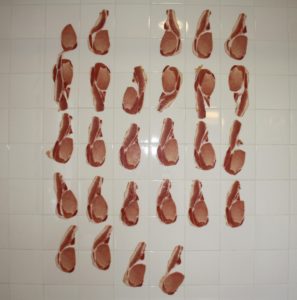
Category Archives: AO1 Develop Ideas
Filters
Developing my ideas
Mood Board

Many artists paintings hide secrets of the subjects in them or demonstrate the conventions of the time whether it be political or the social norms. Photographers are able to look at these mysterious pieces of art and become inspired by recreating aspects in a more modern style to represent current conventions. This inspired the premise of my project where I hope to be able to recreate styles of art, sections of a painting or even techniques.
Secrets, Codes and Conventions | Ideas
Definitions
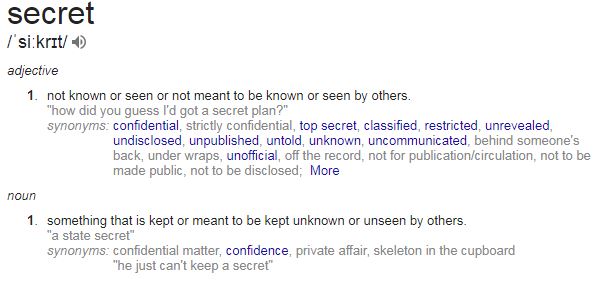


Mind Maps


inspiration 5:Ketty La Rocca
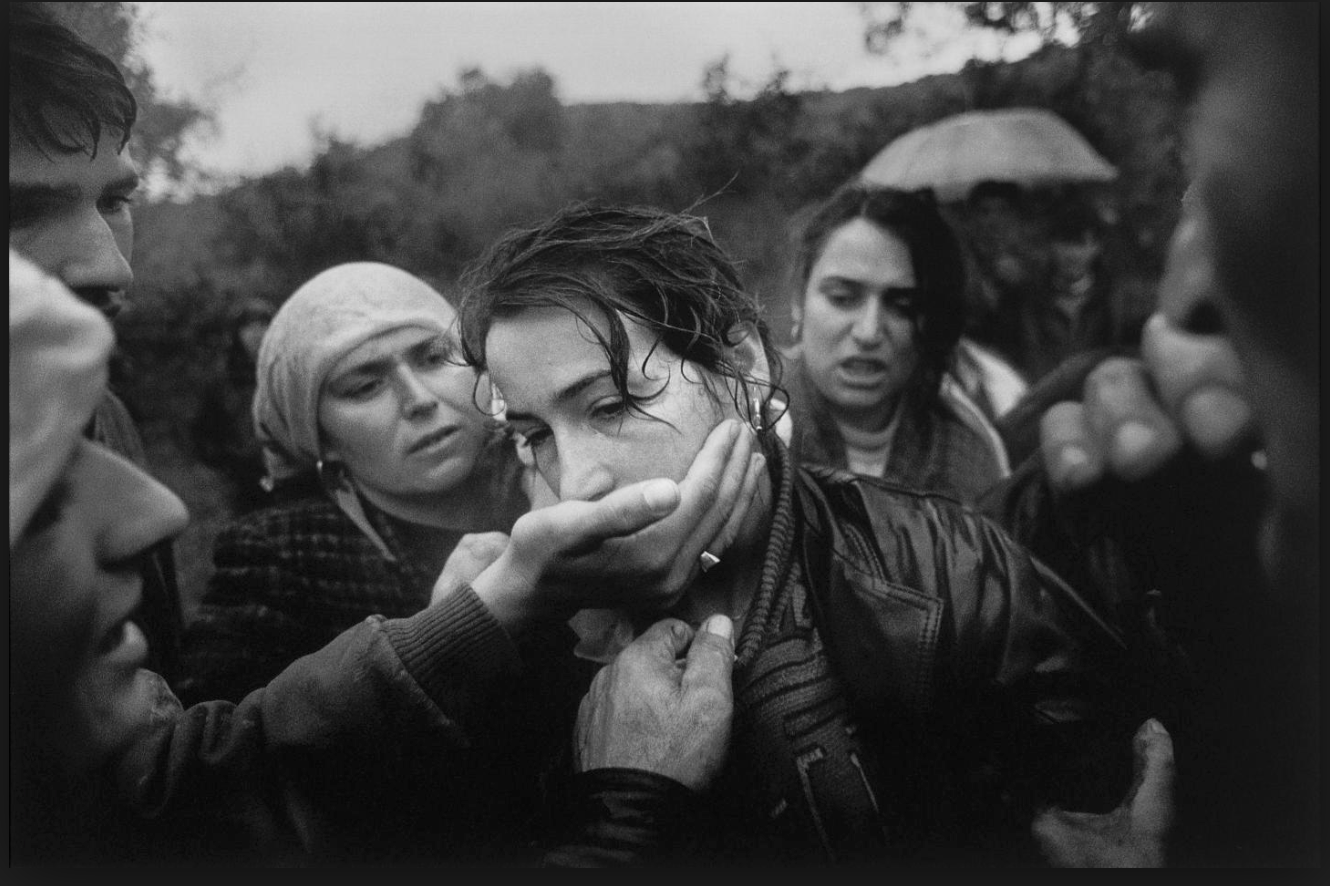
I was inspired by this image due to the composition of the piece centring the women and how she connotes a struggle of her voice being taken away with all the hands heading towards her mouth, It presents a strong relation of humans to violence,and the most important weapons we have is our voice. Although how we are expected to act a certain way due to the environment we grow up in or dependent on our gender.Furthermore the lack of eye contact presents her human emotion and how she is not addressing us directly as she is seen as powerless wihtin the image once again indicating human behaviour of fear due to others influences.
I would further develop this image in order to present more surrealist values possibly adding more hands and creating a more conceptual feel to being trapped and isolated.It again highlights the sense of human struggle and relationships people have to form due to the codes and conventions as where they were raised.
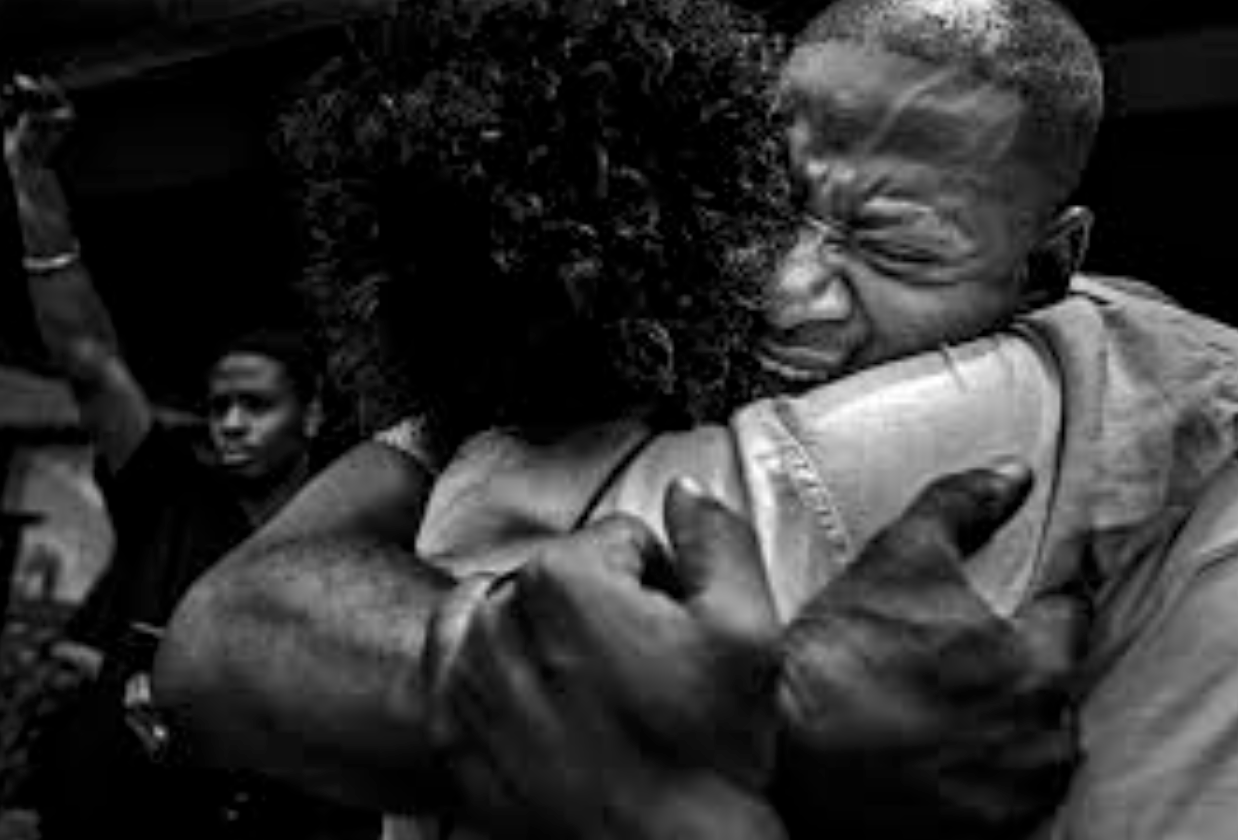
Secondly this image shows a strong sense of raw emotion and additional themes of photo journalism, it shows a presence of emotion as well as conceptual idea presenting peoples feelings and also what they want in the world.

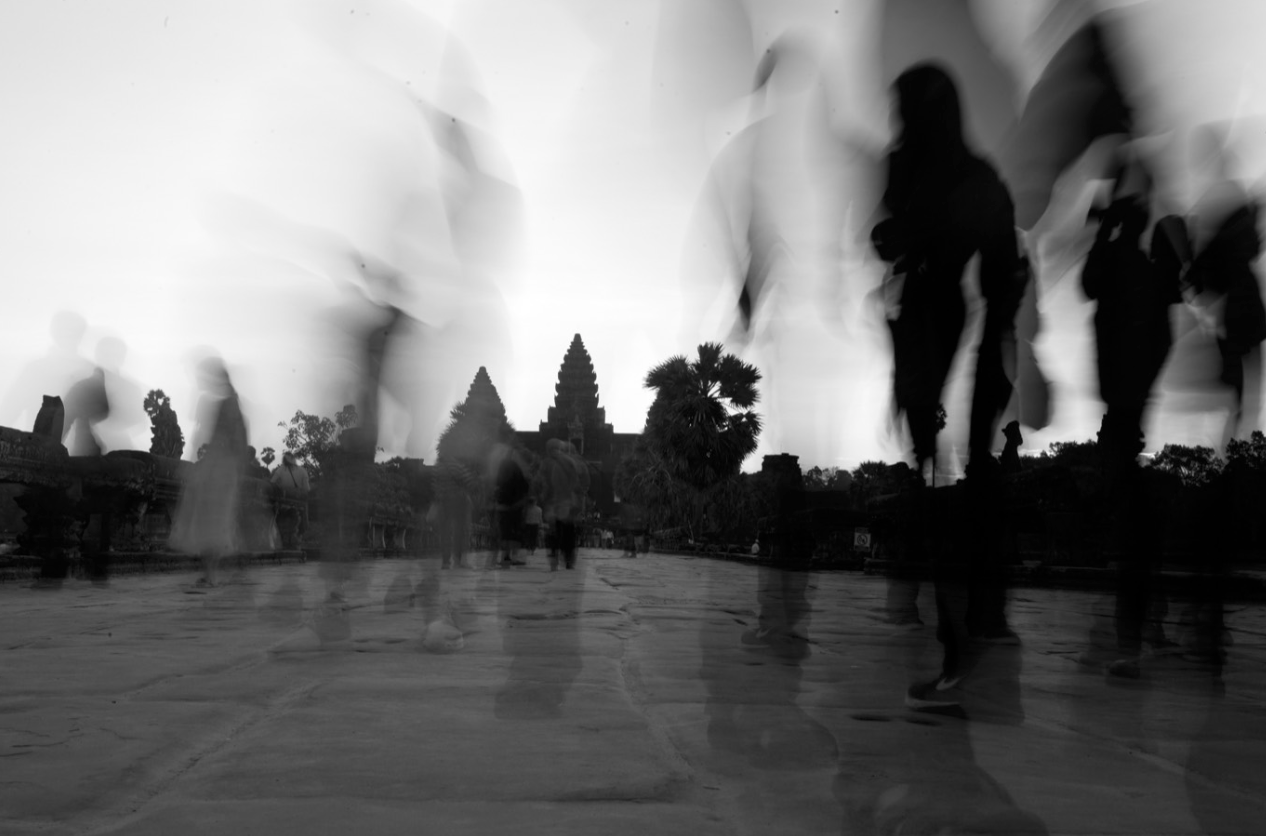
These last two images I was inspired as it tracks human behaviour and activity as one existence and conceptually how we all ignore each other and do not view each other as equal.I think this demonstrates a movement as a wide view to capture society.I wasn’t influenced by a apseicifc artists but more the means at which all photojournalism and surrealism artists work to capture people in a certain light to present a conceptual meaning of truth.
for my shoot I too want to capture truth but will additional edit the images to presents a surrealism effect such as manipulating and adding more hands, or editing the scenario they are surrounded by. locations need to be areas in which travel is highly occurring and used to presents a humans active life and actions .It also presents conventions of a persons life and a routine in which we all stick to as a society because it is how we are expected to behaviour and act as a whole group.
Ketty la rocca
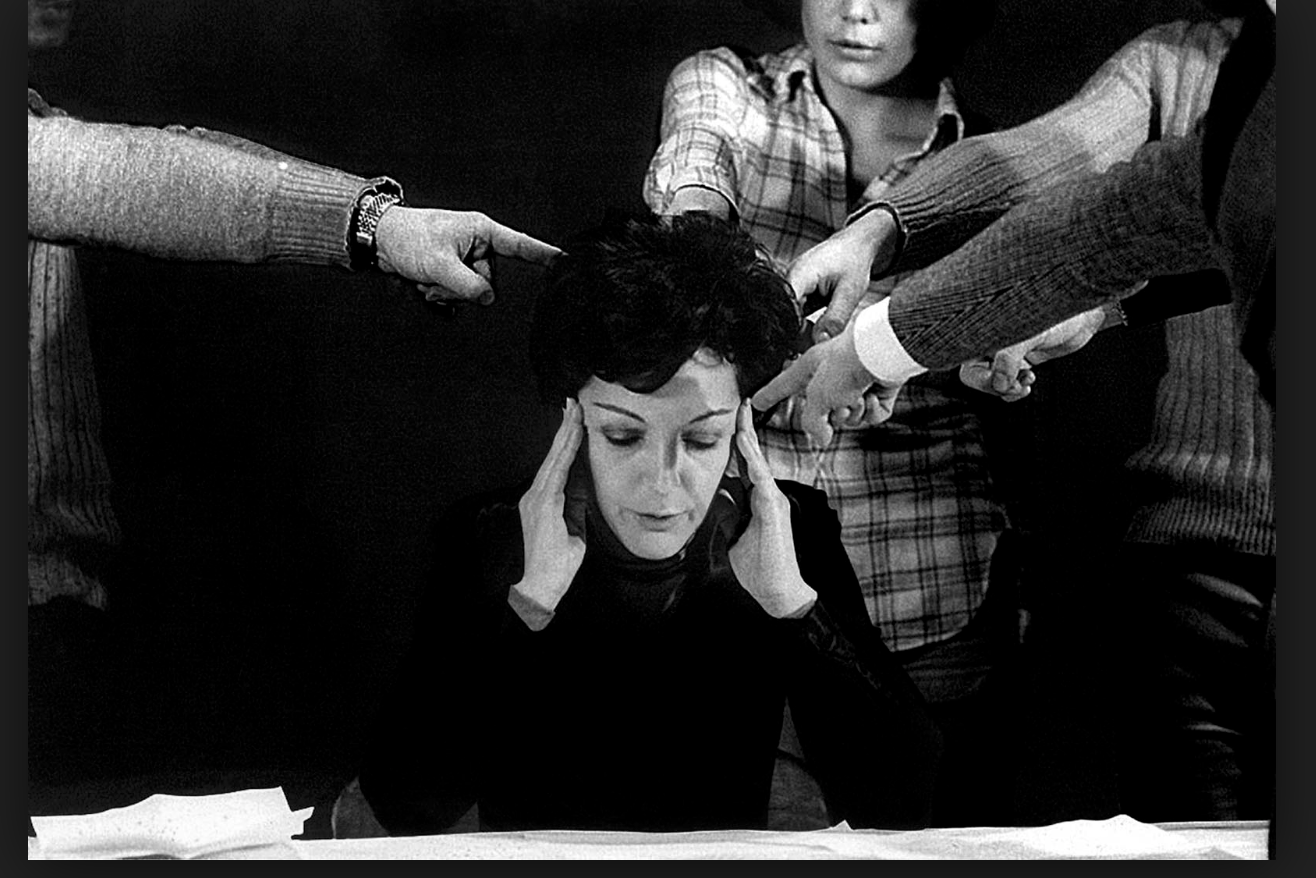
Ketty La Rocca was born 14 July 1938, in La Spezia, Kingdom of Italy – and died 7 February 1976, in Firenze,
Her work focus on beauty conventions and breaking them, this artist specifically also demonstrates human behaviour and the relationship people hold within each other;The art of La Rocca acts as a form of visual poetry, visual art, and performance. She explored language, images, and scenes of the everyday world. She emphasized the imagery of bodies.She examined their potential for expression. She combined hands and words. She desired to create a different language, a more visceral communion in which the physical body, gestures and the written word were intertwined. She was a leading exponent of body art and visual poetry movements.
Analysis of her work:
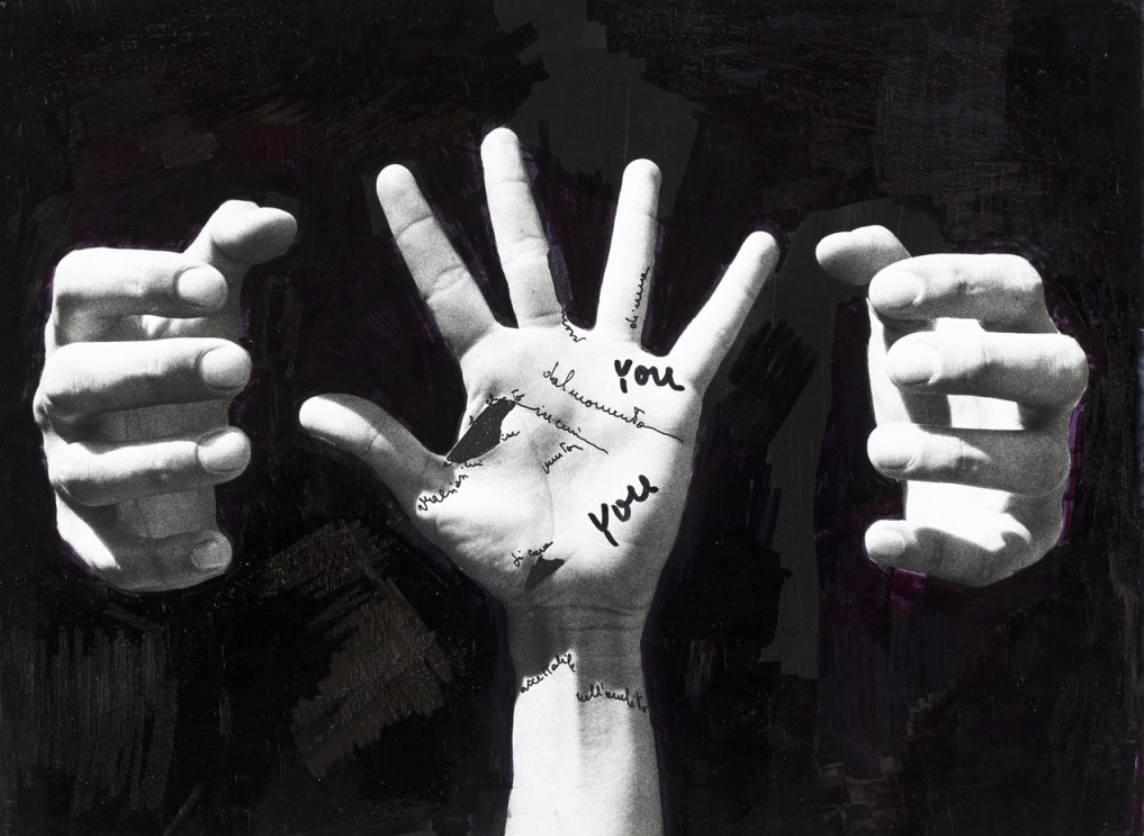 This image is almost symbolic for how we are tried and confined by a certain behaviour or have a constant fear to act or look a certain way. I think my previous idea and this artist would make a very interesting shoot altogether.
This image is almost symbolic for how we are tried and confined by a certain behaviour or have a constant fear to act or look a certain way. I think my previous idea and this artist would make a very interesting shoot altogether.
Walker Evans
Walker Evans (born November 3, 1903) was an American photographer and photojournalist whose influence on the evolution of ambitious photography during the second half of the 20th century was perhaps greater than that of any other figure. Evans had the extraordinary ability to see the present as if it were already the past, and to translate that knowledge and historically inflected vision into an enduring art
His principal subject was the vernacular—the indigenous expressions of a people found in roadside stands, cheap cafés advertisements, simple bedrooms, and small-town main streets.
Evans began photographing regularly in 1928, while living in New York City. It was his goal to become a professional photographer, although it was difficult to find work. His first big break came in 1930, when three of his photographs were selected to be published in a poetry book by Hart Crane, titled The Bridge. This early work foreshadows his life-long interest in the imagery of urban architecture and industrial construction.
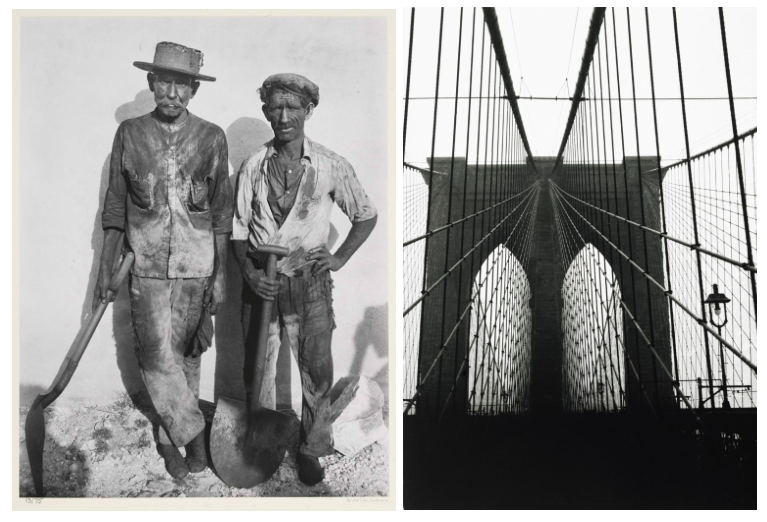
In 1933, Evans traveled to Cuba to take photographs for The Crime of Cuba, a book by American journalist Carleton Beals. Beals’s goal was to expose the corruption of Cuban dictator Gerardo Machado. For this project, Evans produced a number of portrait photographs using laborers, miners, and dockworkers. He also documented the urban street life in Cuba, including images of vendors, pedestrians, and signage. All of these themes would reappear in Evans’s later work for the FSA.
Mature Period
Photography flourished under the Great Depression, thanks to Roosevelt’s New Deal, which paid artists to work. The Farm Security Administration hired Evans alongside other photographers to document the government’s improvement efforts in rural communities. Unconcerned with the political ideology behind his assignment, Evans spent the better part of 1935 and 1936 eloquently capturing the aesthetic texture of ordinary life via rural churches, bedrooms, faded signs, and rumpled work clothes. He avoided using upscale equipment. Despite being familiar with and capable of affording the latest technology, Evans used an outdated camera with a very slow lens.

Evans’ interiors function like landscapes that open up towards other worlds, largely through the particular attention that he pays to the inanimate objects that are present, almost representing them as characters themselves
His book titled – Message from the interior – is both open and reserved, preparing the reader not only for its subject matter, but also for the atmosphere of intensity it contains. Here, through objects and places, the he speaks to us of absence, the difficulty of communication and the passage of time.


Walker Evans picks out details that unsettle our delicate balance with portraits set in living rooms, kitchens or bedrooms. On first impression, the meticulous layout of the images leave room for the disciplined and temporarily deserted places that they depict.
None the less there is resistance, in spite of all of these codes and the apparent passivity of these empty, predetermined spaces. Life is indeed present, in the smell of the wallpaper, the sound of the wooden floors, the slight movements of dust particles and the lengthening of shadows.
These spaces, now emptied of their occupants, rediscover their own life, perspectives stretch out or become flattened; shadows recompose themselves into sculptures, as the objects take over the roles of the missing occupants and complete the story.


Most of Evans’s best work dealt not with people but with the things they made: he was concerned most of all with the character of American culture as it was expressed in its vernacular architecture and in its unofficial decorative arts, such as billboards and shop windows.
In Evans time, there were essentially two competing philosophies of photography: Documentary vs. Pictorialist. Documentary strove to represent the world as it was, flaws and all; Pictorialism produced a selective, transcendent view of the world, akin to traditional Western painting. Evans’s work, a blend of these two philosophies, brought greater nuance to the practice of photography. As he put it, “What I believe is really good in the so-called documentary approach to photography is the addition of lyricism… produced unconsciously and even unintentionally and accidentally by the cameraman.”


During the winter months between 1938 and 1941, Evans strapped a camera to his midsection, cloaked it with his overcoat, and snaked a cable release down his suit sleeve to photograph New York City subway passengers unawares.
For Evans, the subway portraits were an attempt to capture the ultimate purity of a recording method without human interference. He sought to reflect ordinary life in an organic and natural way. The subway portraits were also, in many ways, a rebellion against studio portraiture and the commercialization of photography. Evans criticized the inherently artificial nature of typical portrait photography, with its use of costumes, make-up, props, and posed stances.

inspiration 4:Artist Jesse Draxler
Jesse Draxler

Draxler has such a strong presence through his powerful imagery and attitude of mystery. He charges his work through poignant cuts,scratches ,rips and abstract brush marks. His work typically remains within black and white pallet in order to hold the bold composition of the piece itself.I chose his work as there is such a strong abstract presence as he address his own individuality to enhance an image altogether.when talking about his inspiration he is seen saying:”There is something about defacing an image that is not mine that I dig, much like graffiti I suppose. Image denial, rebellion, a subtle violence or aggression is inherent in that process,Transforming an image from something I may not really care for into something that speaks for me is gratifying, like creation through destruction. Mine now.”
His visual influence is so abstract and even he himself has said it is his own self exploration as how he can make an image his own,In Morden societies culture everything around us is influenced by something else. Fashion and his natural environment is additionally a factor seen effecting his work.He portrays his emotion weather that being a bad or good day into his work to symbolise a numb or positive feeling.He sees himself and his work as one big a ‘human canvas’

I was inspired by his work as he influences peoples appearances and beauty through his own concentrations of his emotions at the time and how this behavior effects the image and itself overall effect.He not only uses collage and editing within Photoshop but also adds substances such as fire and a life effect captured on an image itself. he has such a strong concentration of the subject and only being surrounded by a white background.This image also connects to alternative aspects of itself,using smoke from the eyes and fire from the mouth to symbolize the artists feeling of anger and self isolation. additionally the tones are so exposed with the contrast of white and black throughout with only a glimpse of color.There is an absence of self being and identity within this photo as he has no eyes and mouth so every freedom and sense of self expression and feeling is removed,this is a metaphor for again how we have to behave within a conditioned environment of society and a code of how we have to behave and the conventions of how our voice and personality can be removed by the voices of others.

inspiration for shoot;
For my shoot inspired by his work I will be mostly concentrated on varying angles and lighting of a person and then the main aspect of the image will be the secondary development of how to emotionally enhance the image itself. This could be through editing the image,using collage,using a fire substance or a material to form texture,or possibly using Photoshop to create an unrealistic altered effect to the image itself.I want all my work to have a strong aspect of originality and also unique editing circumstances and compositions to make a detailed analysis of the piece itself and more of the meaning behind what the image symbolizes. I will experiment with the ideas developed above but then also the way in which this changes how that persons beauty conventions have been altered and how the new image mimics a feeling or tone or presence to the piece as a whole.
Secrets, Codes and Conventions – Shoot Three
Planning
Task – Take 150-200 photos exploring the theme of exploration under the key word ‘secrets’
Props – I will be using the natural environment such as trees and overgrown areas along with people and a rundown building.
Camera Settings – Due to deciding to do the shoot in the dark will have to use flash in most of my photographs in order to illuminate the subjects enough. I will be using this with an ISO of 800 and a shutter speed of 1/40.
Lighting – I will be using strong torches or flash from the camera in order to capture these photographs.
Location – St. Saviours hospital
Context – I am looking at the theme of exploration for my AS level externally set assignment.
Concept – I hope to take photographs of the secrets that are the abandoned hospital and the overgrown areas around it whilst taking inspiration from Emmanuel Tecles
My Response
Contact Sheet

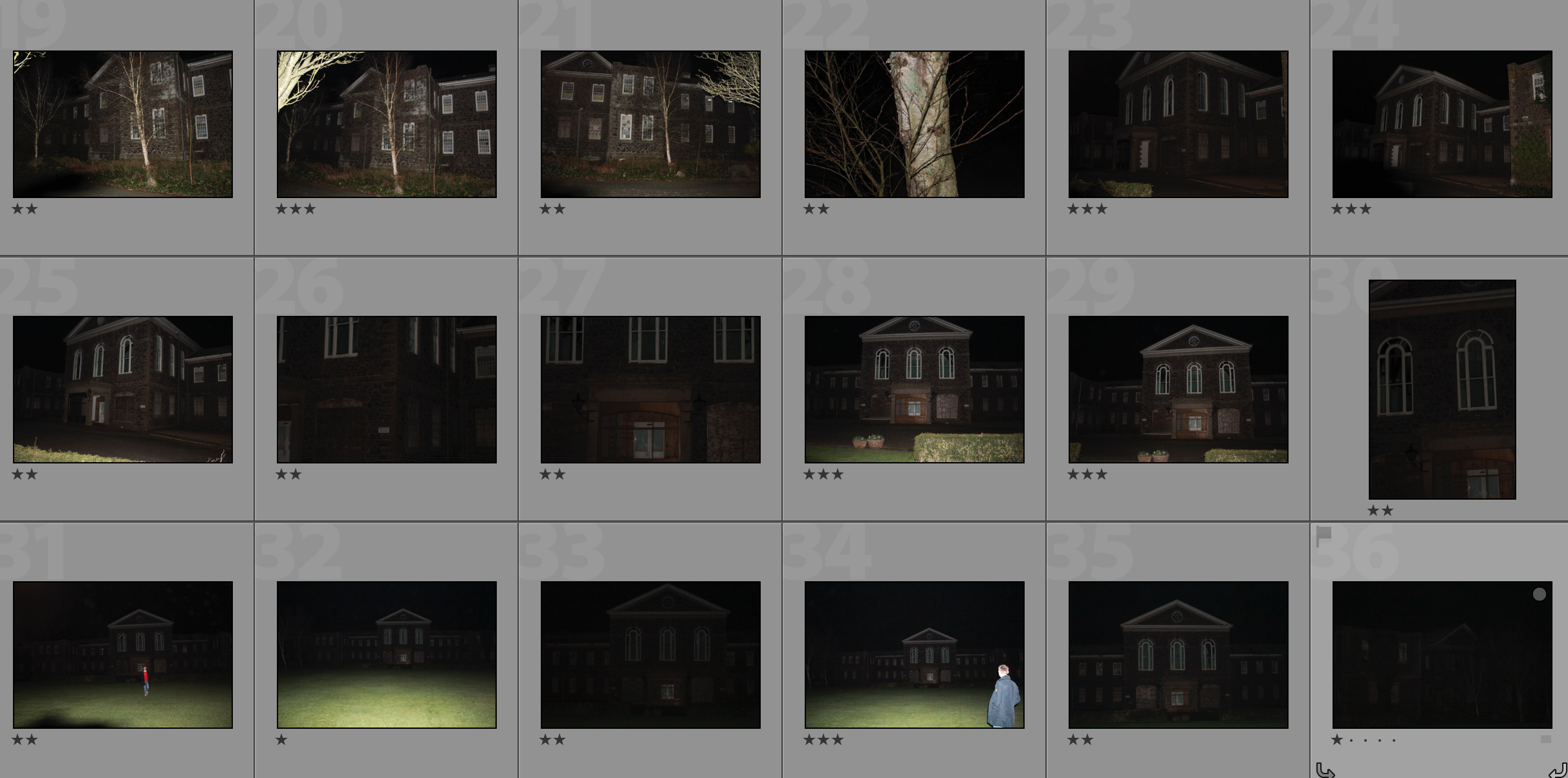
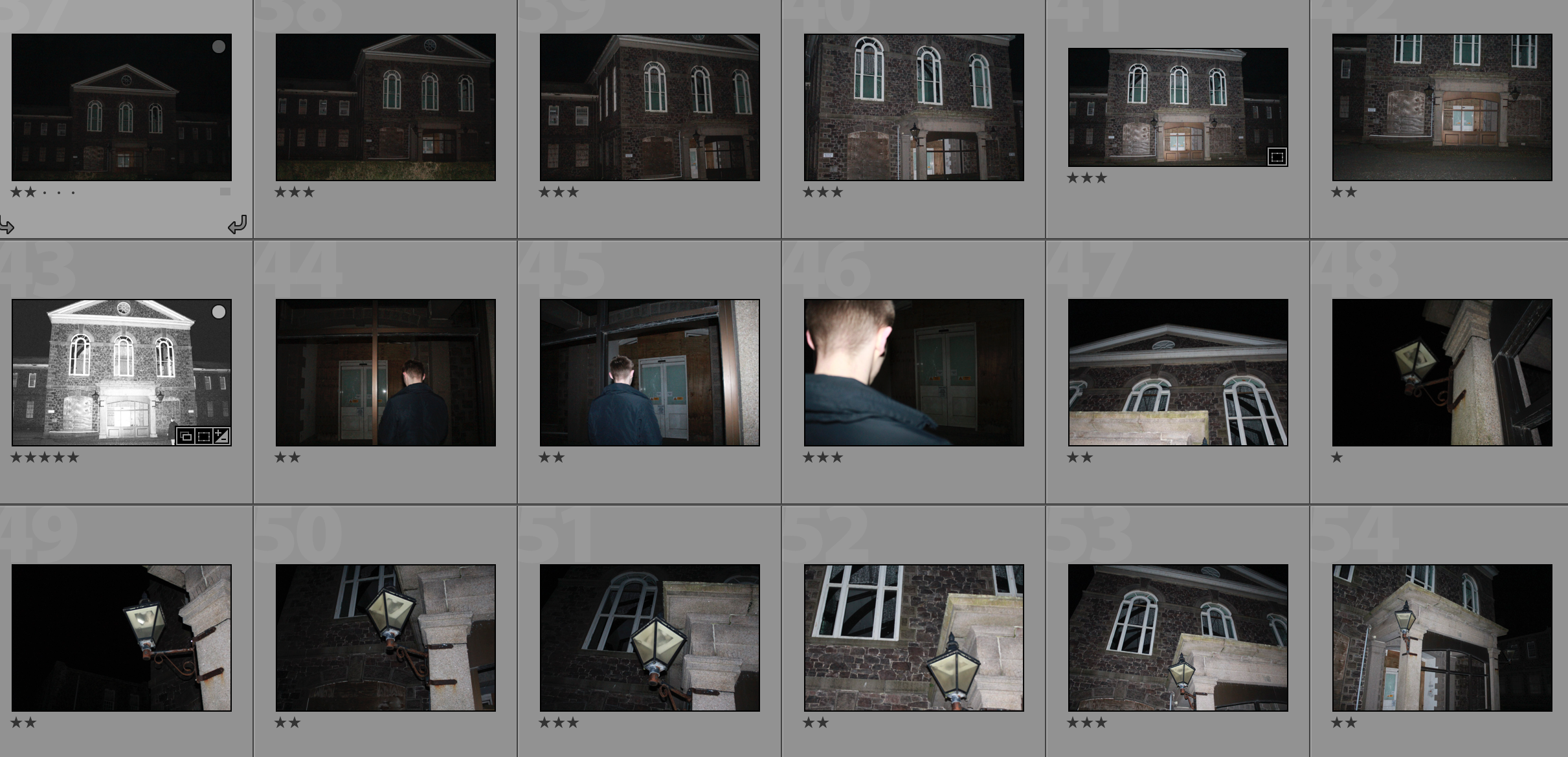
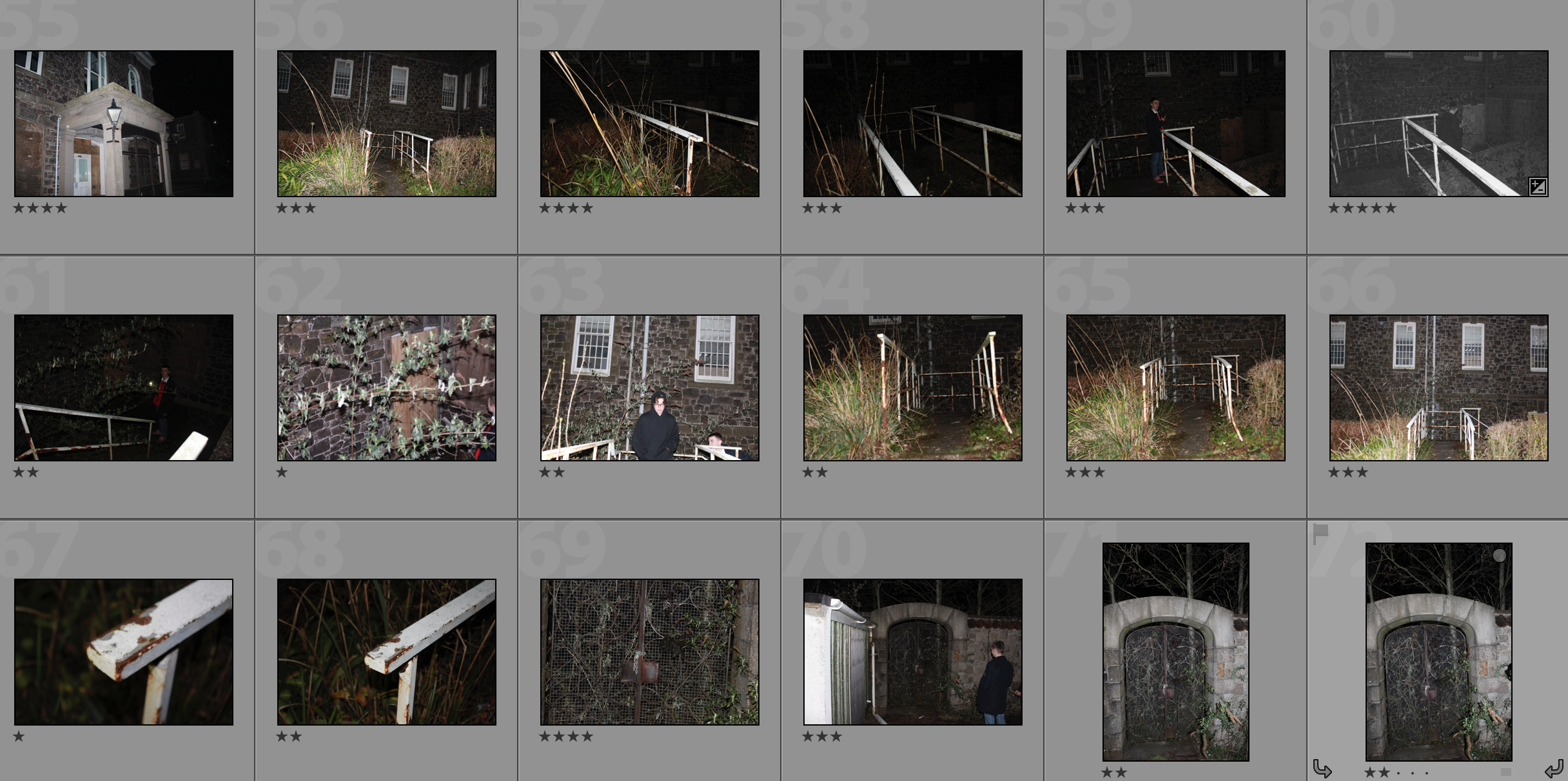
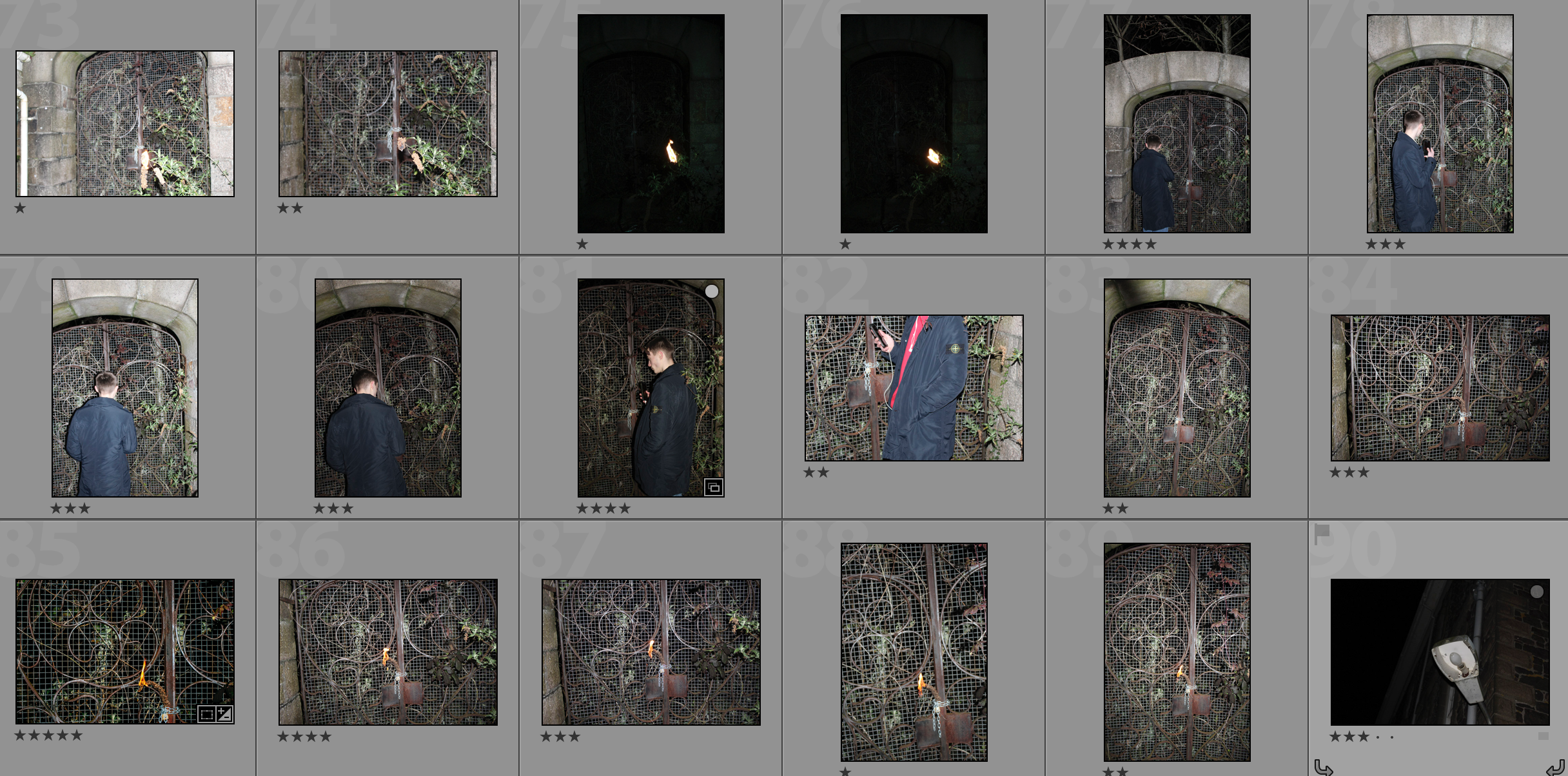
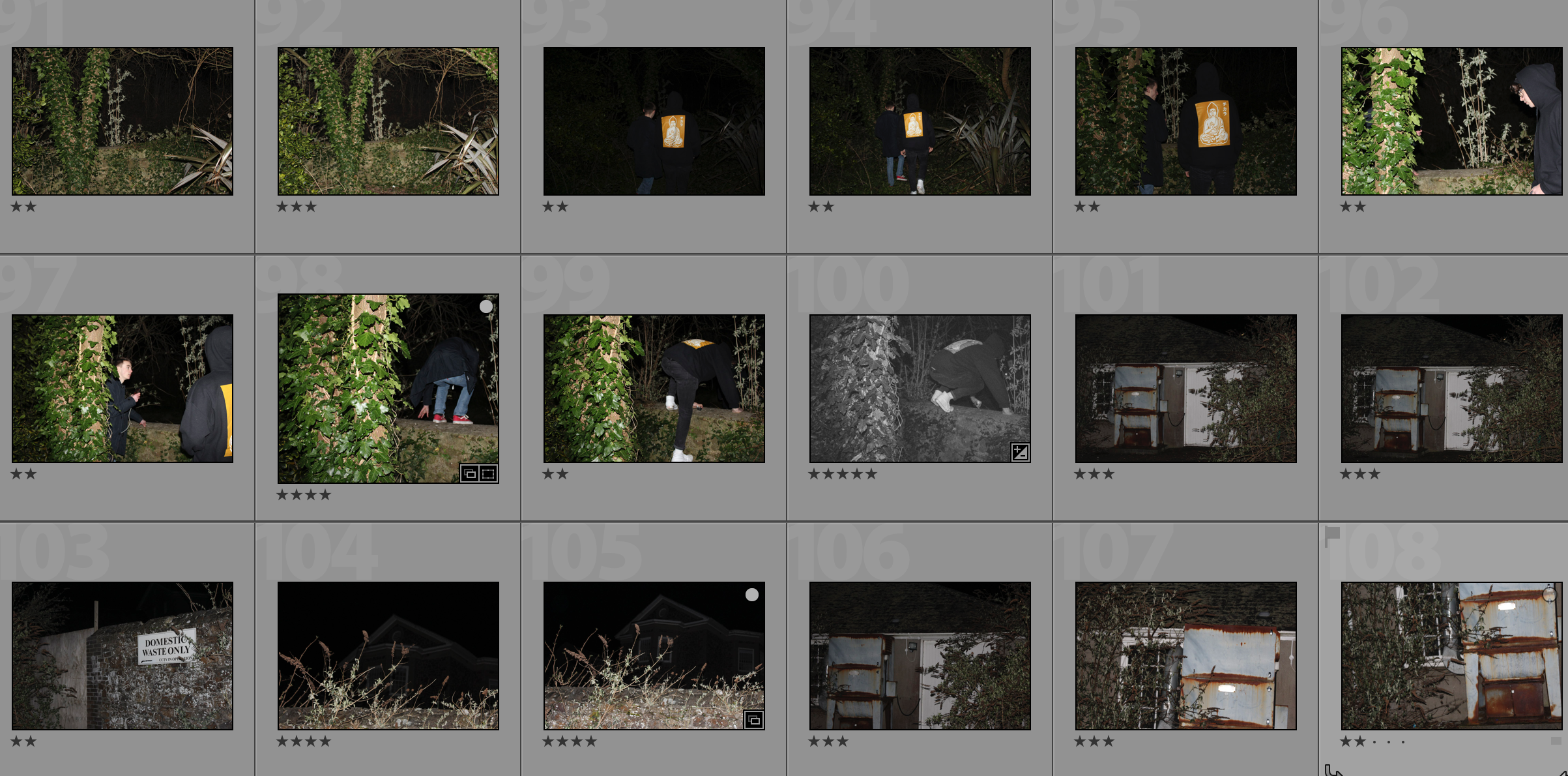
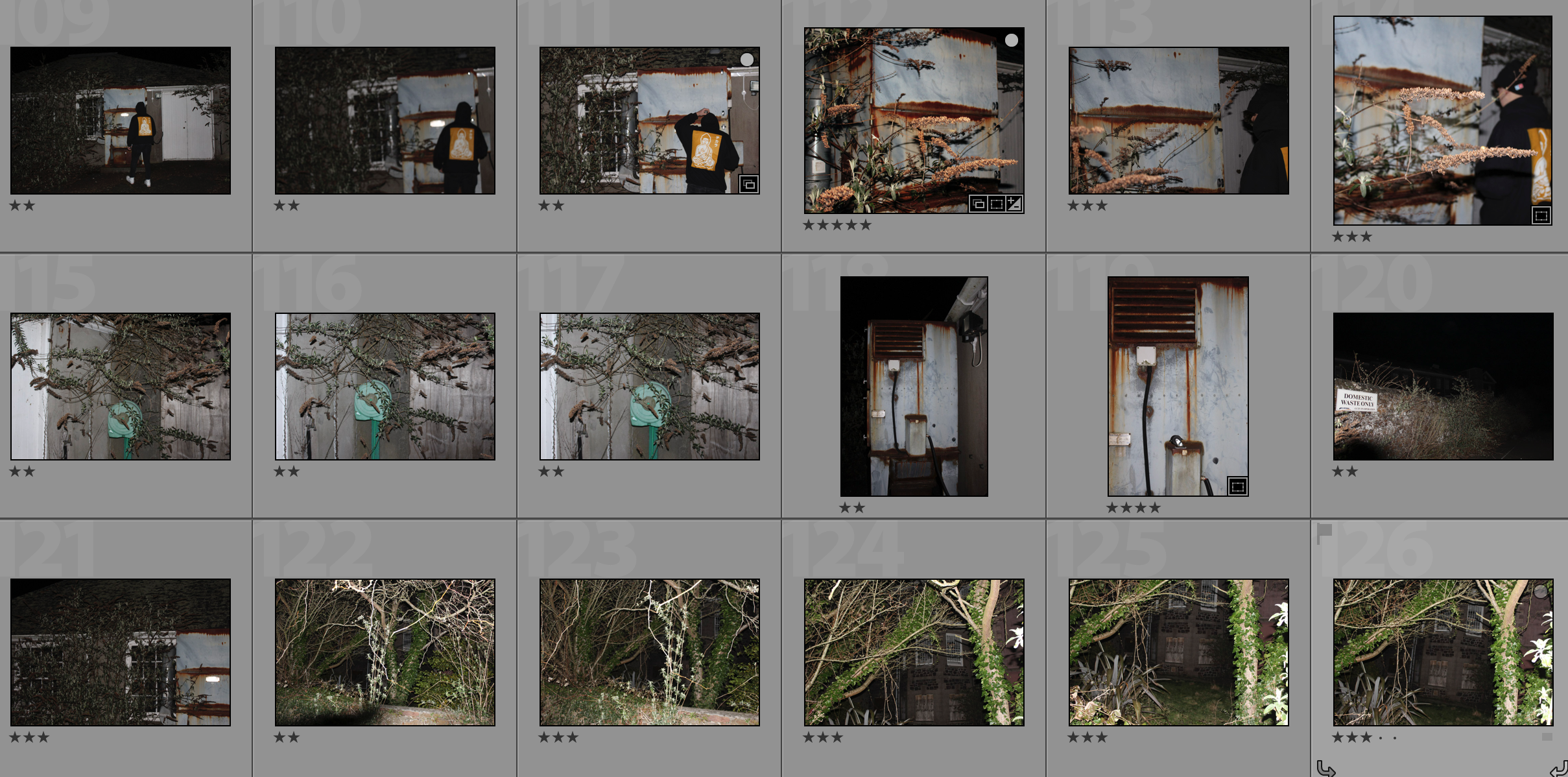

Edits
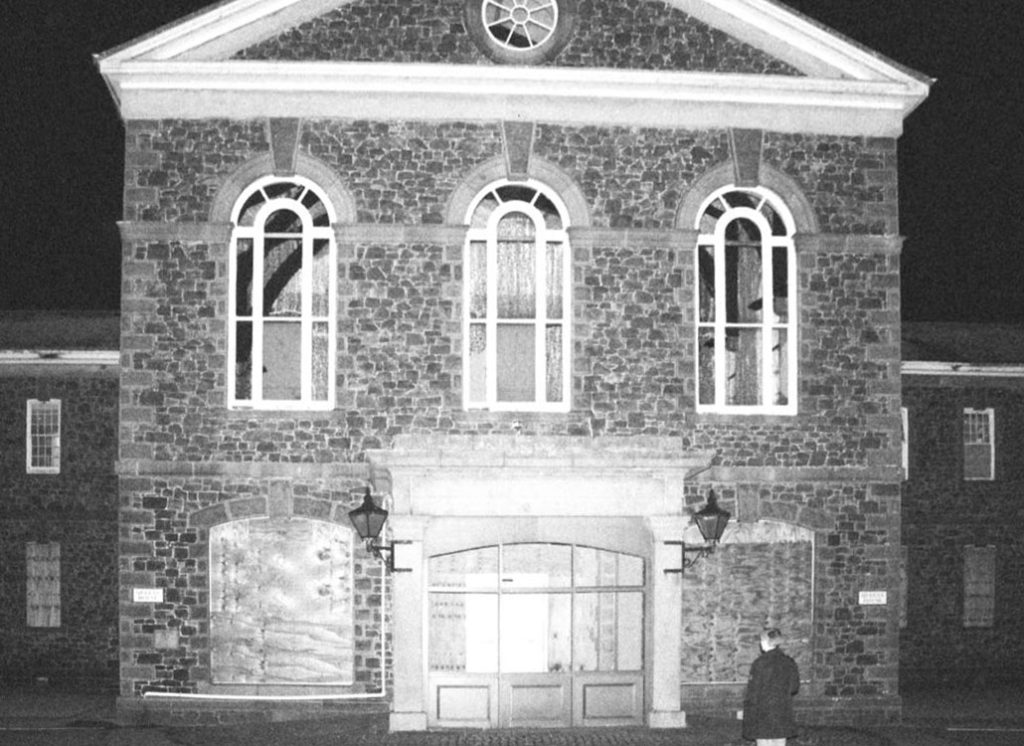

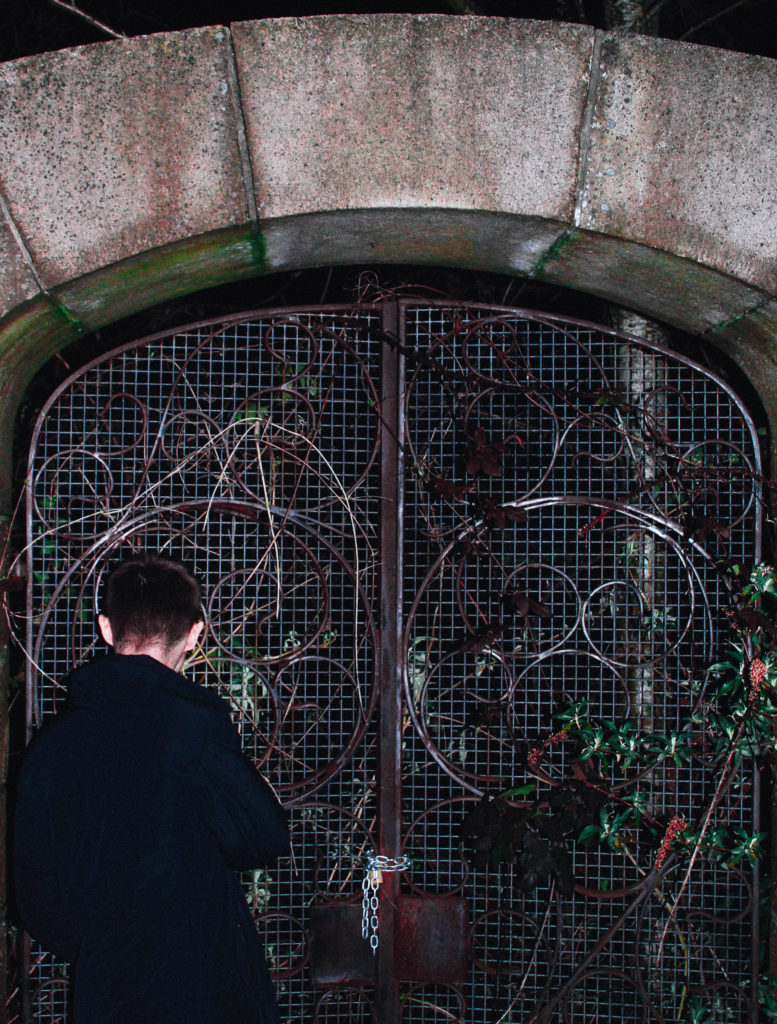

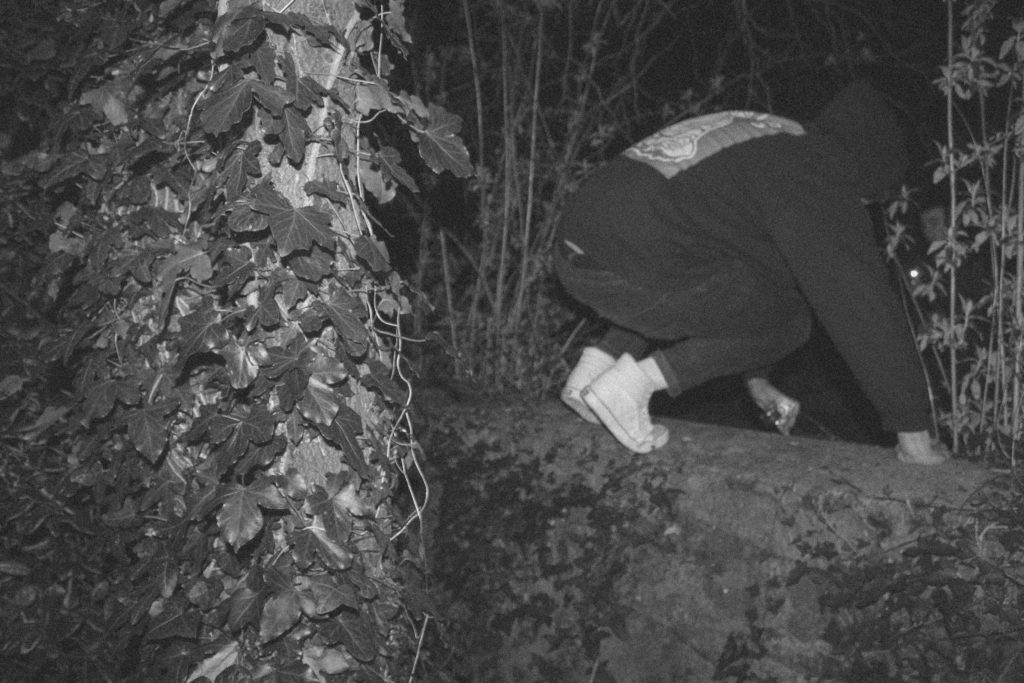

My Favourite Photograph
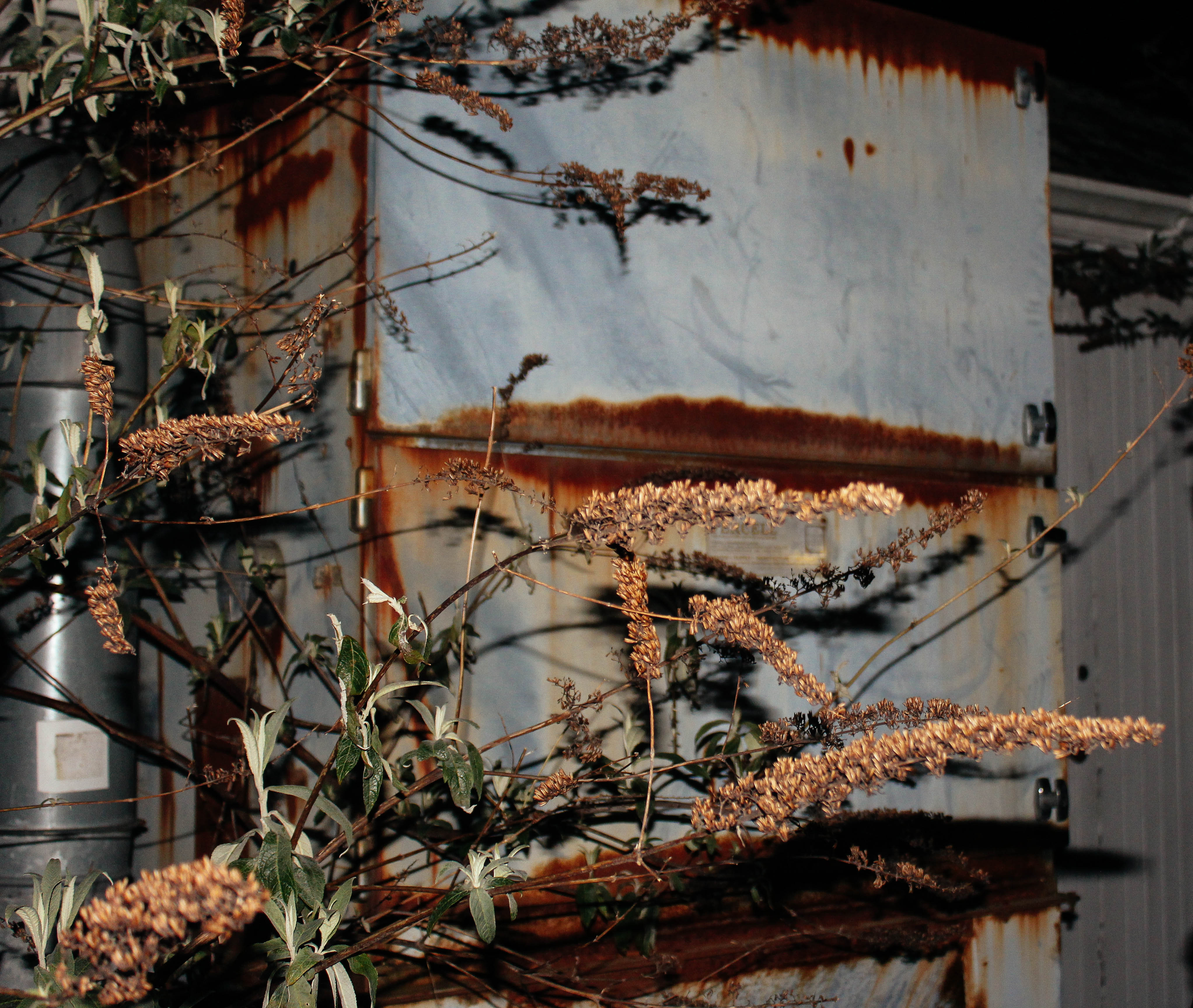
This photograph was taken with the flash on. This allowed me to create contrast between the shadows and the highlights within the photograph. I used a flash as the environment that I was taking photographs in was dark. Along with the flash I used an ISO of 400 to brighten up the photograph and a shutter speed of 1/40. For aperture I used a shallow depth of field, as this created a slight blurred effect in the background in order to separate the background and foreground.
In this photograph I used a natural colour scheme consisting of yellows and browns. This helped to convey a sense of natural decomposition. There is quite a 3D effect in this photograph due to the use of the flash and the low depth of field as the foreground and background have been separated. The tonal range in the photograph is fairly dark which creates a more mysterious photograph.
I took this photograph outside of the abandoned St. Saviours hospital – I chose this location due to the mystery and secrets about it. A lot of the area is overgrown and worn down so I decided to capture photographs of the disintegration of the area. This photograph in particular looks at a mysterious and dark atmosphere. It looks at the traces of the mystery of the area and the nostalgic history behind it. In this photograph I attempted to bring mystery and a sense of exploration into it in order to show that the building has many secrets about it that remain untouched in the abandoned area.
landscape sea shoot development,third artist:Tony Hertz
Original inspiration
For my third artists I wanted to expand my ideas further from the behavior of people and focus upon the behavior of nature and a pathetic flallsey effect and how nature has emotions and more power over humans.I want to portray a more free sense of nature and the environment not being held back by man made creations. I was originally inspired by the following images:I also want to focus on the conventional laws of how nature and how it is seen to behave and how we cannot actually predict its actions and its behaviour is a clear opposition to the lack of identity that people continuously show.
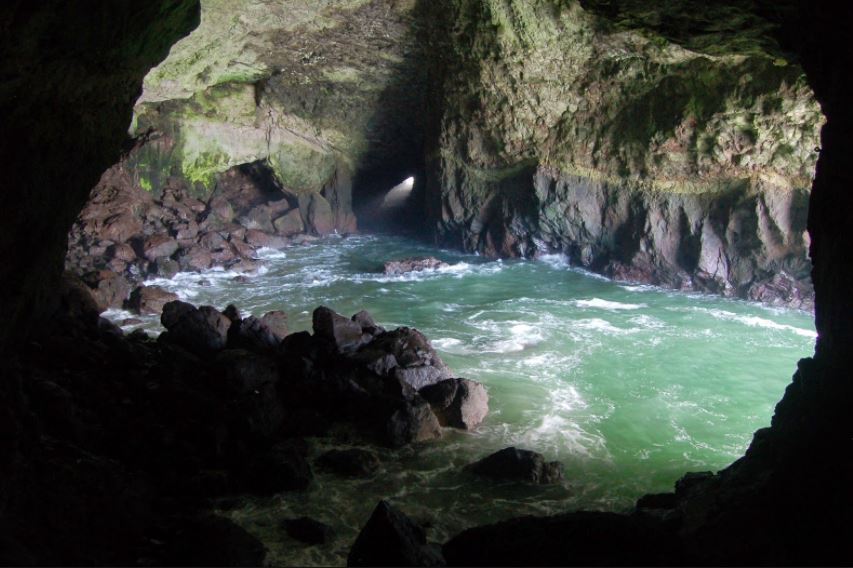
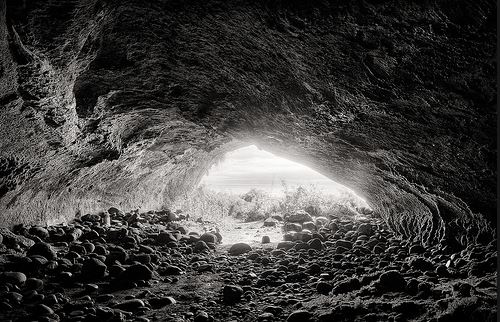

Third artists:Tony Hertz
He’s been recognized with top awards for his landscape photographs.His work has been published widely, including Outdoor Photographer Magazine, Photographer’s Forum, Silvershotz and Black and White Magazines. Tony has over 35 years of professional photography experience with 10 years of it as a daily newspaper photographer. While working as a photojournalist it helped refine his compositional instincts.Then he turned to focus mainly on landscape and nature subjects for personal and fine art photography work. he become interested within photography in his early years of childhood when fining a box camera.At age 10 he was drawn to LIFE magazine and any book or tabloid that contained photos which in turn inspired him on his creative adventure. in 1971 he soon enrolled in a photography class in San Bernardino Valley College.Afterwards he earns a liberal art degree and continued to teach photography.,while also learning the composition and techniques of the newspaper photographs. he soon became ;photojournalist;list of the year’ gaining skills of editing images and communicating within editors and photographers on story ideas and preventions. in the mid 1980’s he started to refine his compositional instincts and technically hone his photography skills. More importantly, it brought himself into many situations and experiences with interesting people and events that shaped me professionally and personally.
I Chose this work due to the way the phototherapy divides his time equally shooting and then editing his work and additionally teaching traditional film photography and digital photography. within his work he has such diverse techniques and methods in order to capture the different atmospheres within landscapes and different methods in which to present nature and water,some of his work:

image anyslsis:

critical anyslsis:I Was inspired by this image as it presents a softer feel to nature and a long shutter speed in order to capture a movement of the water,This questions the conventions of the expectation of nature and the presentation of how it works and can be presented.for my shoot I can develop the behaviour of nature demonstrating more stormy isolated weather as seen before and more romantisced nature to symbolises a behaviour we present and don’t show to people,furthermore the abstract sense and unpredictability that nature symbolises demonstrates the power nature has over people and how its strength can change the way people act and behave.
second artist: midori harima and shoot ideas
These are some examples in which I was inspired(separate from the artists work):
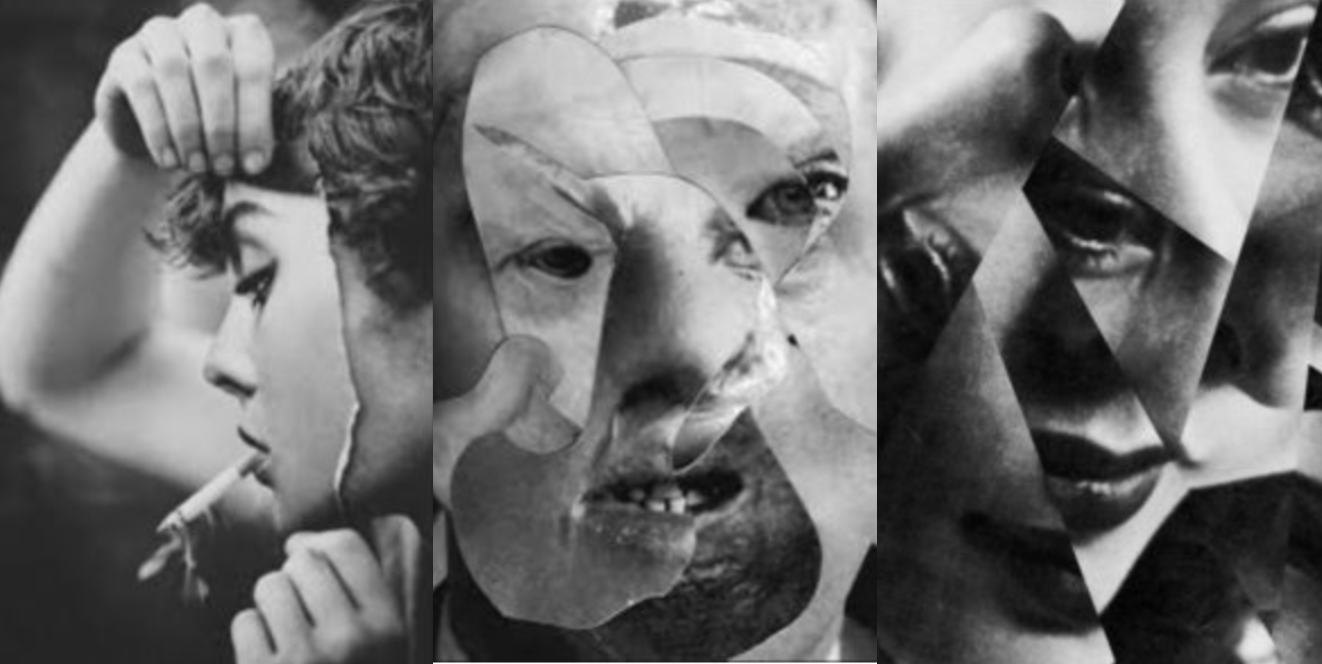
I was fascinated with the distortion within people due to either a self inflicting issue reflected onto themselves to mirror an emotion, this would come under their own personal secret and view of themselves and the continuous convention of people being subjected to portray a certain aspect of themselves to others.This would come under a surrealistic aspect and also possibly from using mirrors and or collage as well as Photoshop techniques within the image.
Second artist:Midori Harima
Harima relocated to the United States in 2001, and currently maintains a studio in New York. She is known for her technique of creating hollow paper sculptures from archival paper, onto which she has pasted photocopied images from magazines, newspapers, and other conventional media. By gathering and linking together fragments of the visual information that inundates today’s society, and thereby raising issues that cannot be represented by other means, her work leads to the discovery of intuitive beauty for which her practice is highly acclaimed.During her more recent work she links her ambition to projects featuring democracy and new inspiration from daily life such as every daily consummations and considering how this effects the democracy and as a whole within society.
why I chose her work:
I was originally inspired by the somewhat gruesome observations of identity and the conventions that we are not who we present others that we are, I was also interested wihtinn the collage and inventive way in which the faces were formed or even futher experimented wihtin using dolls and a reflection of behaviour and almost a code of a set way in which we have to behavouir and also look all the time. Harima relates sucessfully to this as her work shows a sense of emotion of a 3d image but onto a face stuture,bringing alive something that does not exist,and an emotion and we deem relastic to the surrounding society.
Favourite image analysis:
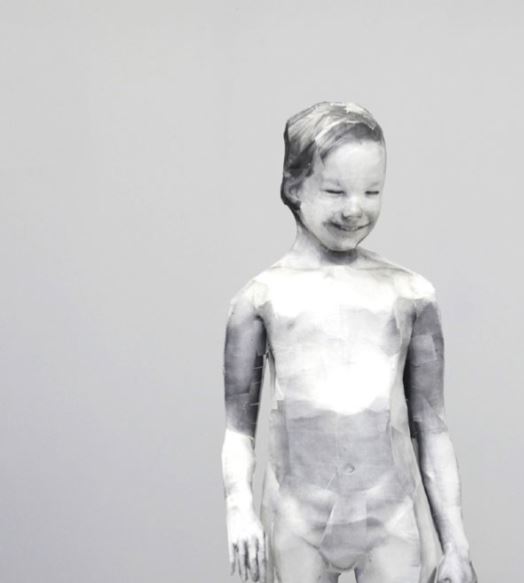
This image holds many connotations of being removed in many aspects, which creates an eerie sense due to the lack of colour and loss of humanness wihtin the image itself, it possess many characteristics to which a human should obtain but are lacking, such as movement and an expression but most importantly the image of the face is added over the head so the proportions are a way to present the image .It possesses many questions and fits into secrets codes and conventions as their is such a lack of colour and being it possess so much mystery wihtin the relationship of the body and the image form of the head itself,It once again fits into a theme of isolation and a confromative act of behaviour in which we have to comfort to as a code and how the face is smiling but is clearly a fake emotion.This could also be produced by collage seen above by my unrelated originally inspired images which led me to this artist.There is a clear sense of insecurity projected from herself onto her work and once gain highlights a false sense of security whitin a child being not being real.
inspiration from her work:
what I can take from her work is the way in which she forms a structure in order to demonstrate a false emotion and a consistent juxtaposition of trying to demonstrate a positive emotion. This links to my first artists as it constitutes for an act of behaviour and false sense of self.
Secrets, Codes and Conventions – Second Shoot
Planning
Task – Take 150-200 photos exploring the theme of exploration under the key work ‘secrets’
Props – I will be using the natural environment including the trees and plants that I come across as props and possibly people in some of the photographs.
Camera Settings – Due to deciding to do the shoot in the dark will have to use flash in most of my photographs in order to illuminate the subjects enough. I will be using this with an ISO of 800 and a shutter speed of 1/40.
Lighting – I will be using strong torches or flash from the camera in order to capture these photographs.
Location – St. Catherines Woods
Context – I am looking at the theme of exploration for my AS level externally set assignment.
Concept – I hope to take photographs of the woods in ways that would not be usually seen and to show the secrets that the dark can contain whilst taking inspiration from Emmanuel Tecles.
My Response
Contact Sheets



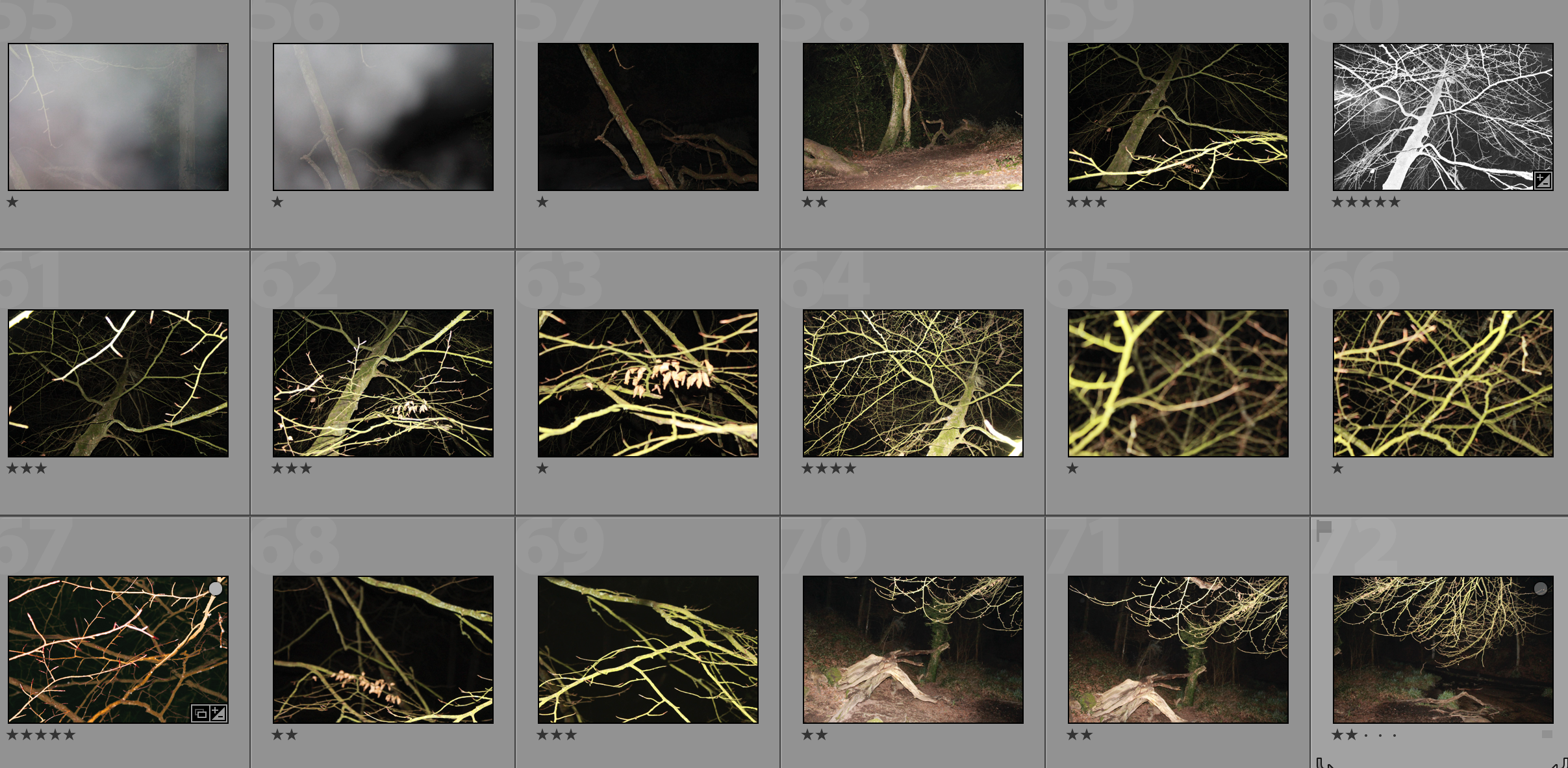


My Top 5 / Edits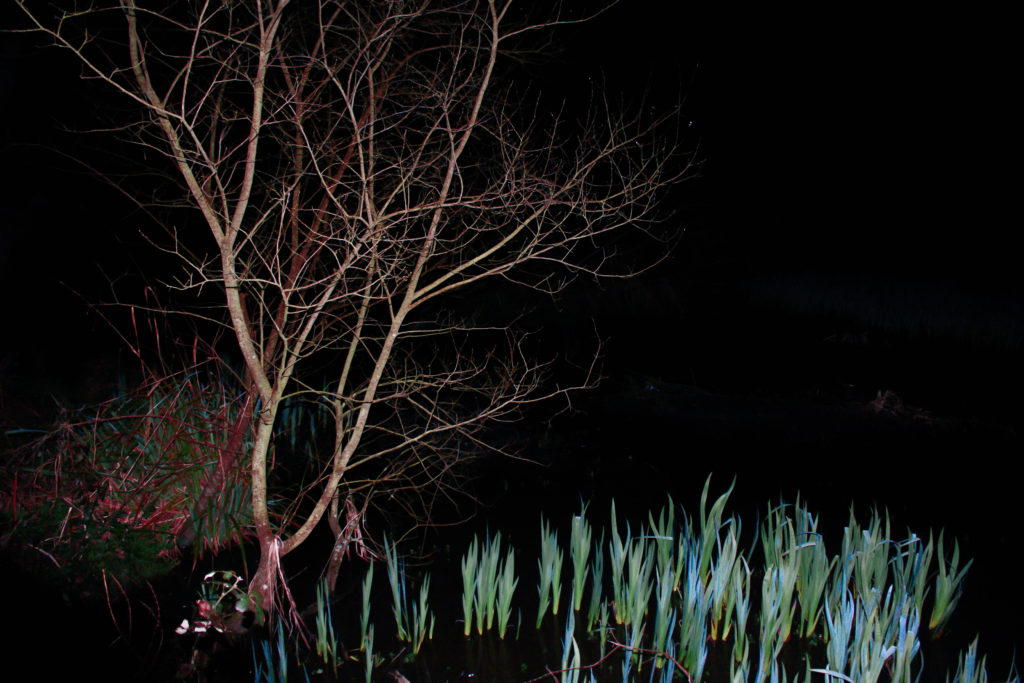


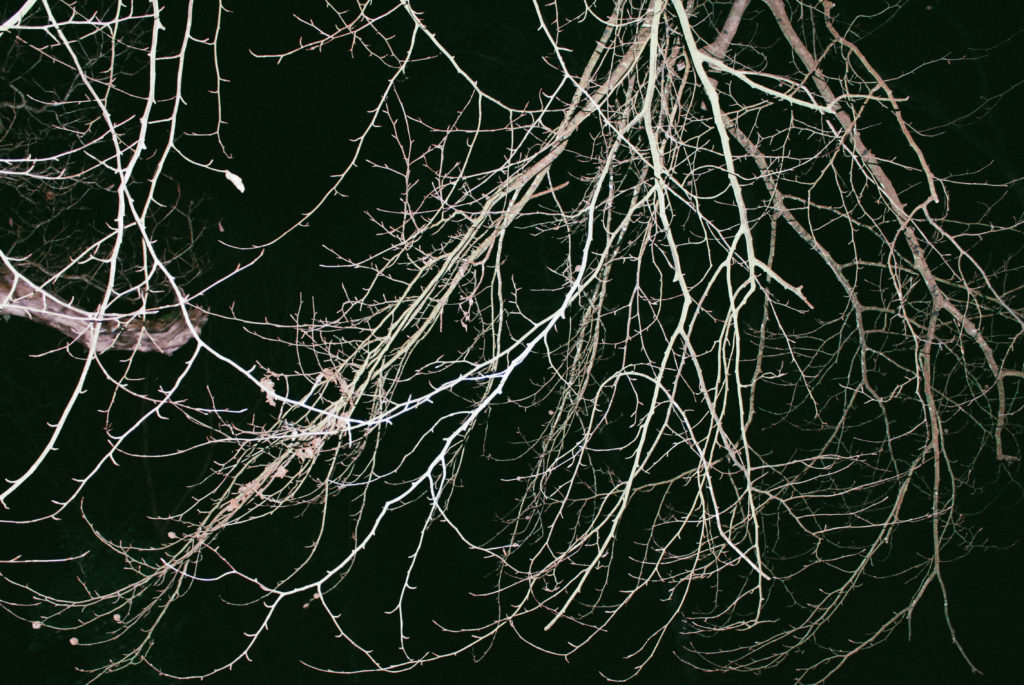
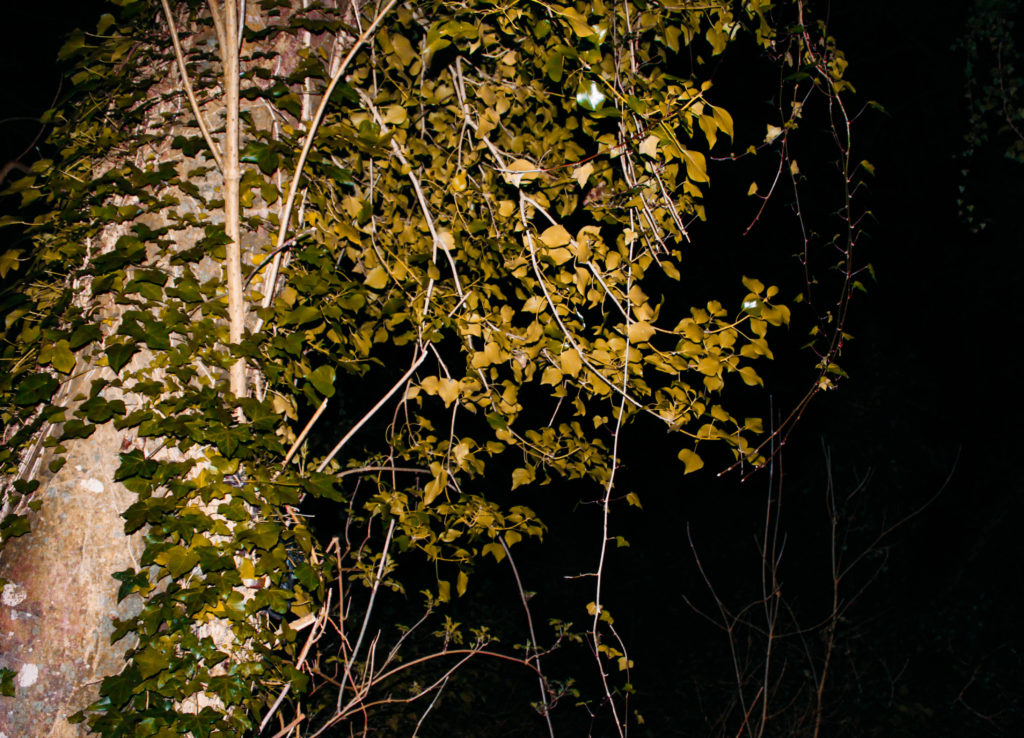
My Favourite Photograph
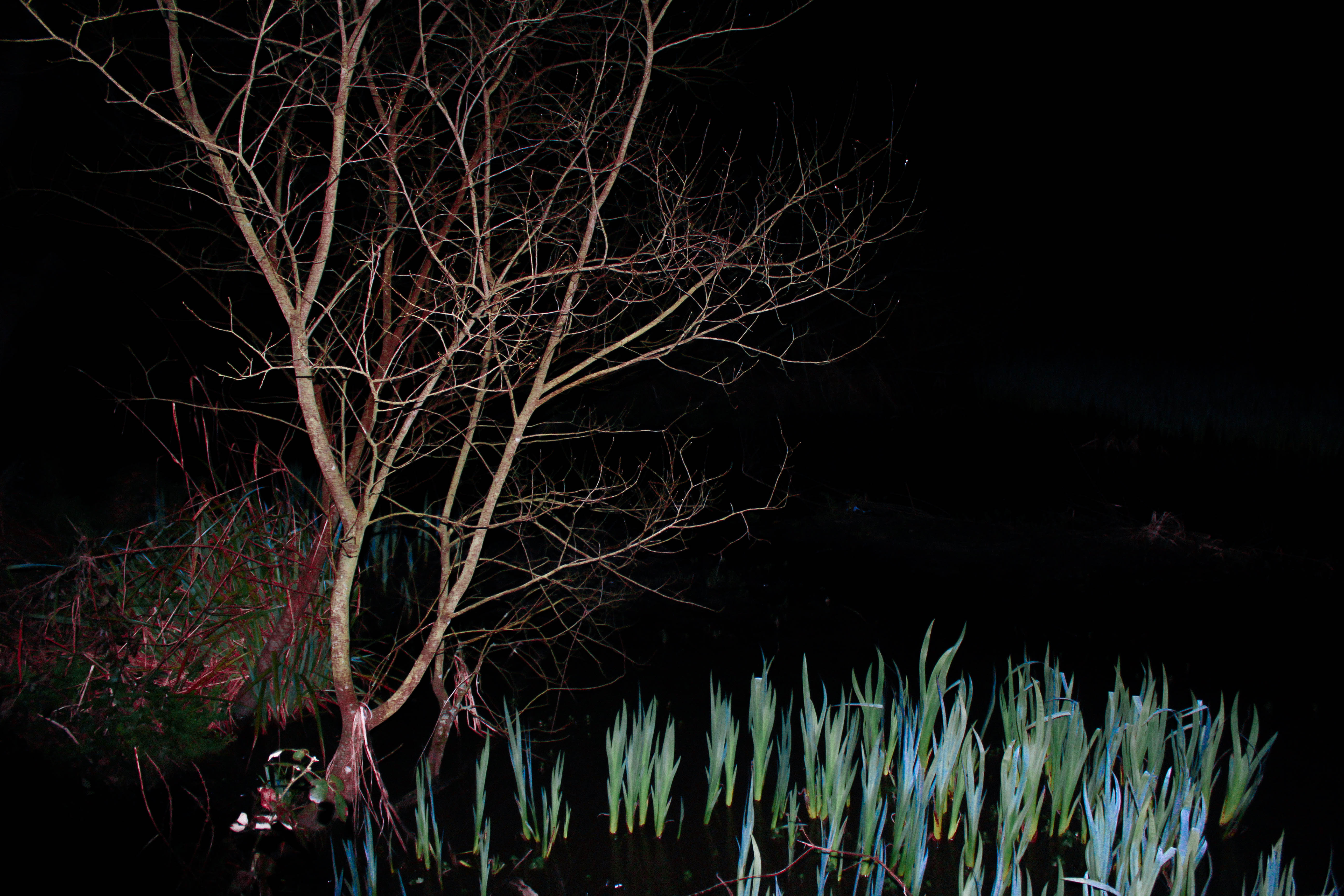
This photograph was taken using flash as the area was dark with no light in the area. This allowed me to illuminate the subjects of my choice and create contrast between the background and foreground. I used a shutter speed of 1/40 with an ISO of 800 in order to make sure the picture was bright enough to be seen – this helped to further emphasise the gap between foreground and background.
The colours within this photograph provide more contrast with the background – the bright vibrant colour of the pondweeds contrasts with the dull colour of the tree and the surroundings to create an interesting photograph. There is a wide tonal range in this photograph ranging from the highlights in the tree and pondweed to the purely black background, this helps to focus on the subjects of the photograph. There is a 3D effect in this photograph as you can clearly see the plants upfront as the background fades into darkness. I positioned the tree in line of one of the vertical lines of the rule of thirds in order to create a more interesting photograph.
This photograph was taken at night in St. Catherines Woods. It shows contrast between living plants and dead plants in an eery environment. The concept of this photograph is that it may be something that many people will see and walk past every day but when the subject is illuminated at night it shows another side of the view – almost its secret. It shows off the different branches of the dead tree individually and brings out the colour in the pondweeds to create a different environment.

